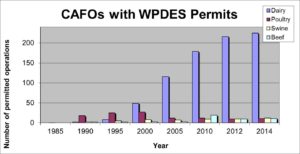In a 2011 study conducted by the University of Vermont, stemming from clean water issues in revered Lake Champlain, results were inconclusive as to whether organic farming or conventional farming practices favor a cleaner lake.
What is suggested is, all other things being equal, the rigidity of organic farming standards (some of which are noted below) lend themselves to better land management practices – which may have a positive impact in reducing the nutrient (see: manure) runoff that is largely responsible for Harmful Algae Blooms (HABs). Some standards mentioned are:
- All organically raised animals must have access to the outdoors, including access to pasture for ruminants. They may be temporarily confined only for reasons of health, safety,
the animal’s stage of production, or to protect soil or water quality.
Beyond Clean Water: Organic Farms Command Higher Retail Prices. - Land must have no prohibited substances applied to it for at least 3 years before the harvest of an organic crop.
- Soil fertility and crop nutrients will be managed through tillage and cultivation practices, crop rotations, and cover crops, supplemented with animal and crop waste materials and allowed synthetic materials.
According to the study, a challenge the organic farmer with animals faces, which a conventional farmer may not, is keeping pastured animals from directly wading into streams and lakes — instantly polluting the water.
- For grazing animals it is important to regulate the extent to which the cows interact with natural waterways. Where livestock have access to these waters there is an increased risk of nutrient losses to surface water.
Clearly the motivation to go organic in farming extends beyond better land management — and the chart above illustrates the financial incentive that may accompany such a move — but there appears to be little doubt that agriculture runoff remains a chief contributor to pollution in Lake Champlain. This is largely consistent across the USA, wherever clean water issues arise.



